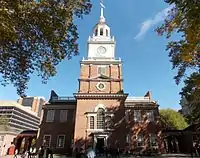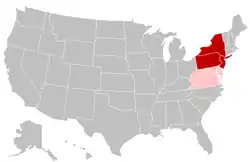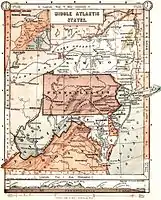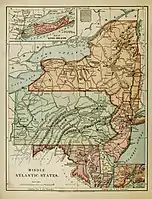Mid-Atlantic (United States)
The Middle Atlantic states, commonly shortened to Mid-Atlantic states, is a region of the United States generally located in the overlap between the Northeastern and Southeastern States. Its exact definition differs upon source, but the region usually includes New York, New Jersey, Pennsylvania, Delaware, Maryland, Washington, D.C., Virginia, and West Virginia. When discussing climate, Connecticut is sometimes included in the region, since its climate is closer to that of the Middle Atlantic states than the rest of the New England states.[3] The Mid-Atlantic has played an important role in the development of American culture, commerce, trade and industry;[4] in the late 19th century, the Mid-Atlantic was called "the typically American" region by Frederick Jackson Turner.
Mid-Atlantic | |
|---|---|
   .jpg.webp)    Left-right from top: Manhattan skyline, Independence Hall in Philadelphia, Assateague wetlands, Panorama of Philadelphia, Catskill Mountains, Pittsburgh skyline, Panorama of Washington, D.C. | |
 | |
| Coordinates: 41°N 77°W | |
| Composition | |
| Metropolitan areas | |
| Largest city | New York |
| Area | |
| • Total | 191,308.5 sq mi (495,487 km2) |
| Population (2008 est.)[1] | |
| • Total | 57,303,316 |
| • Density | 300/sq mi (120/km2) |
| GDP | |
| • Total | $2.962 trillion (2007) |
Euro-Americans of Mid-Atlantic society have their ancestral origin from its settlement by Dutch, Swedes, English Catholics, and Quakers through to the period of British rule, and beyond to the current day. Religious pluralism existed, particularly in Maryland, which was the only Catholic-majority colony of the original Thirteen Colonies. After the American Revolution, the Mid-Atlantic region hosted each of the historic capitals of the United States, including the current federal capital, Washington, D.C. In the early part of the 19th century, New York and Pennsylvania overtook Virginia as the most populous states and the New England states as the country's most important trading and industrial centers. Large numbers of German, Irish, Italian, Jewish, Polish and other immigrants transformed the region, especially coastal cities such as New York City, Newark, Philadelphia and Baltimore, but also interior cities such as Pittsburgh, Rochester, Albany and Buffalo. New York, with its skyscrapers, subways, and the Headquarters of the United Nations, emerged in the 20th century as an icon of modernity and American economic and cultural power. By the 21st century, the coastal areas of the Mid-Atlantic were thoroughly urbanized.
The Northeast Corridor and Interstate 95 link an almost contiguous sprawl of suburbs and large and small cities, forming the Mid-Atlantic portion of the Northeast megalopolis, one of the world's most important concentrations of finance, media, communications, education, medicine and technology. The Mid-Atlantic is a relatively affluent region of the nation, having 43 of the 100 highest-income counties in the nation based on median household income and 33 of the top 100 based on per capita income. Most of the Mid-Atlantic states rank among the 15 highest-income states in the nation by median household income and per capita income. The region is home to some of the most prestigious universities in the nation and world including Columbia University, Cornell University, Johns Hopkins University, the University of Pennsylvania, and Princeton University, which rank among the top 20 universities in the United States and the top 25 universities in the world.[5][6]
Defining the Mid-Atlantic
There are differing interpretations as to the composition of the Mid-Atlantic, with sources including in the region a number of states from New York to South Carolina.[7] A United States Geological Survey publication describes the Mid-Atlantic Region as all of Maryland, Delaware, the District of Columbia, Pennsylvania, and Virginia, along with the parts of New Jersey, New York, and North Carolina that drain into the Delaware and Chesapeake Bays and the Albemarle and Pamlico Sounds.[8] Sometimes, the nucleus is considered to be the area centered on the Washington metropolitan area, including Maryland, Virginia, Delaware and West Virginia.[9]
West Virginia and Virginia are atypical of this region in a few ways. They are the only states to lie primarily within the Southern American dialect region,[10] and the major religious tradition in both states is Evangelical Christian, 30% in Virginia and 39% in West Virginia.[11] Although a few of West Virginia's eastern panhandle counties are considered part of the Washington, D.C. MSA, the major portion of the state is rural, and there are no major or even large cities.[12]

 An 1897 map displays an inclusive definition of the Mid-Atlantic region.
An 1897 map displays an inclusive definition of the Mid-Atlantic region. An 1886 "Harper's School Geography" map showing the region, exclusive of Virginia and West Virginia.
An 1886 "Harper's School Geography" map showing the region, exclusive of Virginia and West Virginia.
History

Shipping and trade have been important to the Mid-Atlantic economy since the beginning of the colonial era.
The explorer Giovanni da Verrazzano was the first European to see the region in 1524. Henry Hudson later extensively explored that region in 1611 and claimed it for the Dutch, who then created a fur-trading post in Albany in 1614. Jamestown, Virginia was the first permanent English colony in North America, it was established seven years earlier in 1607.
From early colonial times, the Mid-Atlantic region was settled by a wider range of European people than in New England or the South. The Dutch New Netherland settlement along the Hudson River in New York and New Jersey, and for a time, New Sweden along the Delaware River in Delaware, divided the two great bulwarks of English settlement from each other. The original English settlements in the region notably provided refuge to religious minorities, Maryland to Roman Catholics, and Pennsylvania to Quakers and Anabaptist Pennsylvania Dutch. In time, all these settlements fell under English colonial control, but the region continued to be a magnet for people of diverse nationalities.
The area that came to be known as the Middle Colonies served as a strategic bridge between the North and South. The New York and New Jersey campaign during the American Revolutionary War saw more battles than any other theater of the conflict. Philadelphia, midway between the northern and southern colonies, was home to the Continental Congress, the convention of delegates who organized the American Revolution. The same city was the birthplace of the Declaration of Independence in 1776 and the United States Constitution in 1787, while the United States Bill of Rights was drafted and ratified, and the first Supreme Court of the United States sat for the first time, in the first capital under the Constitution at New York.
While early settlers were mostly farmers, traders, and fishermen, the Mid-Atlantic states provided the young United States with heavy industry and served as the "melting pot" of new immigrants from Europe. Cities grew along major ports, shipping routes, and waterways. Such flourishing cities included New York and Newark on opposite sides of the Hudson River, Philadelphia on the Delaware River and Baltimore on the Chesapeake Bay.
Major cities and urban areas


Metropolitan areas
| MSA | 2016 Estimate | 2010 Census | |
|---|---|---|---|
| 1 | New York-Newark-Jersey City, NY-NJ-PA | 20,153,634 | 19,567,410 |
| 2 | Washington-Arlington-Alexandria, DC-VA-MD-WV | 6,131,977 | 5,636,232 |
| 3 | Philadelphia-Camden-Wilmington, PA-NJ-DE-MD | 6,070,500 | 5,965,343 |
| 4 | Baltimore-Columbia-Towson, MD | 2,798,886 | 2,710,489 |
| 5 | Pittsburgh, PA | 2,342,299 | 2,356,285 |
| 6 | Virginia Beach-Norfolk-Newport News, VA-NC | 1,726,907 | 1,676,822 |
| 7 | Richmond, VA | 1,281,708 | 1,208,101 |
| 8 | Buffalo-Cheektowaga-Niagara Falls, NY | 1,132,804 | 1,135,509 |
| 9 | Rochester, NY | 1,078,879 | 1,079,671 |
| 10 | Albany-Schenectady-Troy, NY | 881,839 | 870,716 |
| City | 2016 Est. | |
|---|---|---|
| 1 | New York, NY | 8,537,673 |
| 2 | Philadelphia, PA | 1,567,872 |
| 3 | Washington, D.C. | 681,170 |
| 4 | Baltimore, MD | 614,664 |
| 5 | Virginia Beach, VA | 425,602 |
| 6 | Pittsburgh, PA | 303,625 |
| 7 | Newark, NJ | 281,764 |
| 8 | Jersey City, New Jersey | 264,152 |
| 9 | Buffalo, New York | 259,902 |
| 10 | Norfolk, Virginia | 245,115 |
State capitals
- Albany, New York
- Harrisburg, Pennsylvania
- Trenton, New Jersey
- Dover, Delaware
- Annapolis, Maryland
- Richmond, Virginia
- Charleston, West Virginia
Note: The Mid-Atlantic region is also home to the nation's capital, Washington, D.C..
In presidential elections
| Parties | |||||||||
| Nonpartisan | Federalist | Democratic-Republican | National Republican | Democratic | Whig | Know Nothing | Republican | Constitutional Union | Progressive |
- Bold denotes election winner.
Culture
Sports
The Mid-Atlantic is home to 33 professional sports franchises in the five major leagues and the two most prominent women's professional leagues:
| NFL | NHL | MLB | NBA | MLS | WNBA | NWSL | |
|---|---|---|---|---|---|---|---|
| New York/New Jersey | Giants Jets | Devils Islanders Rangers | Mets Yankees | Knicks Nets | NYC FC Red Bulls | Liberty | Sky Blue |
| Washington | Washington Football Team | Capitals | Nationals | Wizards | United | Mystics | Spirit |
| Philadelphia | Eagles | Flyers | Phillies | 76ers | Union | ||
| Pittsburgh | Steelers | Penguins | Pirates | ||||
| Baltimore | Ravens | Orioles | |||||
| Buffalo | Bills | Sabres |
Notable golf tournaments in the Mid-Atlantic include the Barclays, Quicken Loans National and Atlantic City LPGA Classic. The US Open, held in New York, is one of the four Grand Slam tennis tournaments, whereas Washington Open is part of the ATP World Tour 500 series.
Notable motorsports tracks include Watkins Glen International, Dover International Speedway and Pocono Raceway, which have hosted Formula One, IndyCar, NASCAR, World Sportscar Championship and IMSA races. Also, the Englishtown and Reading drag strips such have hosted NHRA national events. Pimlico Race Course at Baltimore and Belmont Park at New York host the Preakness Stakes and Belmont Stakes horse races, which are part of the Triple Crown of Thoroughbred Racing.
See also
References
- "State & County QuickFacts". US Census Bureau. Archived from the original on 2020-02-12. Retrieved 2009-04-09.
- "News Release: GDP by State" (PDF). Bureau of Economic Analysis. Archived from the original (PDF) on 2009-05-07. Retrieved 2009-04-16.
- "Middle Atlantic states - region, United States". Encyclopædia Britannica. Retrieved 2 November 2017.
- "United States". Encyclopædia Britannica. 2009. Retrieved 2009-04-09.
- "National University Rankings". U.S. News & World Report. Retrieved 20 March 2020.
- "Best Global Universities Rankings". U.S. News & World Report. Retrieved 20 March 2020.
- "Merriam-Webster". Merriam-webster.com. Retrieved 2017-08-30.
- Earl A. Greene et al. "Ground-Water Vulnerability to Nitrate Contamination in the Mid-Atlantic Region". USGS Fact Sheet FS 2004-3067. 2005. Retrieved 25 April 2013. Note: Although the locator map appears to exclude part of northwestern Pennsylvania, other more detailed maps in this article include all of the state. Often when discussing climate, southern Connecticut is included with the Middle Atlantic.
- "Word Net Definition". Wordnetweb.princeton.edu. Retrieved 2009-04-09.
- Labov, William, Sharon Ash and Charles Boberg, Atlas of North American English: Phonetics, Phonology and Sound Change, Mouton de Gruyter, 2005 Southern Regional Map
- "Religious Landscape Study". Religions.pewforum.org. 11 May 2015. Retrieved 2 November 2017.
- "U.S. Census 2000 Report" (PDF). Census.gov. Retrieved 2 November 2017.
- Earl A. Greene et al. "Ground-Water Vulnerability to Nitrate Contamination in the Mid-Atlantic Region". USGS Fact Sheet FS 2004-3067. 2005. Retrieved 25 April 2013.Note: Although the locator map appears to exclude part of northwestern Pennsylvania, other more detailed maps in this article include all of the state.
Bibliography
- Bodle, Wayne, "The Mid-Atlantic and the American Revolution", Pennsylvania History 82 (Summer 2015), 282–99.
- Heineman, Kenneth J., "The Only Things You Will Find in the Middle of the Road are Double Yellow Lines, Dead Frogs, and Electoral Leverage: Mid-Atlantic Political Culture and Influence across the Centuries", Pennsylvania History, 82 (Summer 2015), 300–13.
- Landsman, Ned C. Crossroads of Empire: The Middle Colonies in British North America (2010)
- Longhurst, James. "'Typically American': Trends in the History of Environmental Politics and Policy in the Mid-Atlantic Region". Pennsylvania History: A Journal of Mid-Atlantic Studies 79.4 (2012): 409–427.
- Magoc, Chris J., "In Search of a Useable—and Hopeful—Environmental Narrative in the Mid-Atlantic", Pennsylvania History, 82 (Summer 2015), 314–28.
- Mancall, Peter C., Joshua L. Rosenbloom, and Thomas Weiss. "Exports from the Colonies and States of the Middle Atlantic Region 1720–1800". Research in Economic History 29 (2013): 257–305.
- Marzec, Robert. The Mid-Atlantic Region: The Greenwood Encyclopedia of American Regional Cultures (2004)
- Richter, Daniel K, "Mid-Atlantic Colonies, R.I.P.", Pennsylvania History, 82 (Summer 2015), 257–81.
- Rosenbloom, Joshua L., and Thomas Weiss. "Economic growth in the Mid-Atlantic region: Conjectural estimates for 1720 to 1800". Explorations in Economic History 51 (2014): 41–59.
External links
 Mid-Atlantic travel guide from Wikivoyage
Mid-Atlantic travel guide from Wikivoyage

